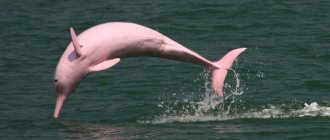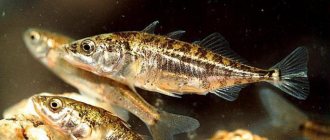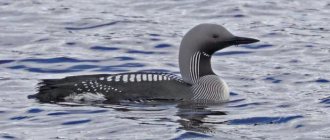Appearance
The white dolphin is a large sea animal. Males are 6 m long, weigh 1.5–2 tons, females are up to 5 m long and weigh up to 1.5 tons. The adult dolphin is white, which is where it got its name.
A newborn baby has a dark blue skin, which becomes grayish as it grows, and then acquires a soft blue color. The blue color fades, and by the age of 5 the dolphin becomes pure white, which remains for its entire life.
The white dolphin has a small head of a special structure; it does not have a beak, which is common to all mammals of this family. There is a fat pad on the forehead that helps the animal navigate the surrounding space. Movable cervical vertebrae allow him to turn his head to the sides.
Having developed facial muscles, the beluga whale is endowed with the ability to reproduce facial movements, showing sadness, joy, contempt or indifference.
The body has wide, small pectoral fins, but no dorsal fin. “Wingless dolphin” is the so-called beluga whale due to the lack of a dorsal fin. The animal has a powerful tail.
The outer cover of the body is durable and characterized by good thermal insulation; its thickness is two centimeters. A thick layer of fat, 15 cm thick, thoroughly protects the internal organs from extreme cold.
White-bellied / Cephalorhynchus eutropia
A beautiful species found off the coast of Chile, which is why they are often called the Chilean dolphin. They grow no more than 170 cm in length and have a stocky body.
Part of the throat, belly and lower part of the flippers are white, but the back and sides are an ordinary gray color. Locals call it Tunina. A rare species of marine mammal is listed in the Red Book.
This is also the least studied species. Scientists cannot even accurately determine the population size.
2
Behavior
The white dolphin moves at a speed of 10 km per hour, and when it is in danger, it can increase its speed to 25 km per hour. The animal feels great swimming on its back or moving backwards. A beluga whale can survive without air for 15 minutes, descending 300 m into the abyss. Swimming, every two minutes it emerges from the water for a breath of air.
The growth of the mammal continues until the age of eleven. Beluga whales live up to 35–40 years, and in captivity they live up to 45.
White dolphins try to live in herds consisting of a large number of groups. In some there are females and cubs, in others there are adult males. A herd can contain up to 90 animals, and the maximum number of heads in a group is 7 individuals.
Closer to spring, animals swim to the northern shores, remaining there throughout the summer, in narrow bays near river mouths, where there is a lot of fish.
The great white dolphin in nature has two enemies:
- a polar bear on land when they find themselves in ice holes;
- killer whale in the water.
Animals are also endangered by the World Ocean, whose waters are constantly being polluted.
White-faced dolphin: description
White-faced dolphins have a fairly powerful build and a muscular body. Such aquatic inhabitants are characterized by curiosity, as well as sociability. Their characteristic features are playfulness and high mobility.
Appearance
White-faced dolphins are characterized by very impressive sizes, as for the inhabitants of the World Ocean. Adults grow on average up to three meters in length, with a body weight of about 350 kilograms. The upper part of the body behind the dorsal fin, as well as the sides of the dolphin, are colored grayish-white. The lower part of the body is almost white. The upper part of the body up to the dorsal fin is colored grayish-black. The dorsal fin, as well as the remaining fins, are blackish in color. The front of the muzzle can be pure white or ash gray. The upper and lower jaws of dolphins are armed with well-developed and powerful teeth, and there are from 25 to 28 teeth on each jaw. The spine of white-faced dolphins consists of 92 vertebrae, which is more than other representatives of this family. These marine inhabitants move through the water at speeds of up to 30 km/h. At the same time, they regularly dive to a depth of up to fifty meters, or even deeper.
White-faced dolphin
Character and lifestyle
These marine inhabitants can be found in temperate waters. They can be located near the coastline, either in pairs or as part of a small group consisting of a dozen individuals. Sometimes they can be seen as part of a large flock, which includes several hundred animals.
Interesting information! White-faced dolphins have not been fully studied at this time. This is due to the fact that these representatives of the dolphin genus are quite rare in the natural environment.
This species of dolphin often migrates in community with other members of the family, such as humpback whales or fin whales. When dolphins form numerous colonies, this fact is evidence of the presence of a large number of food items in these areas of the water area. If there is a sufficient amount of prey in a particular water area, then these animals gather in herds of up to one and a half thousand individuals.
How long do white-beaked dolphins live?
Living in their natural environment, white-faced dolphins live up to four decades, but in captivity their life expectancy is significantly reduced.
Sexual dimorphism
Female dolphins are distinguished by the presence of a single urogenital fold that runs parallel to their belly. The anus is also located in this fold. In the anterior part there is dense fibrous tissue that forms a clearly visible clitoris. Its body is cavernous, with the external genitalia represented by both the labia minora and labia majora.
Interesting moment! Male white-beaked dolphins are significantly larger in size than females.
The genital organs of males are represented by the presence of a perineum, which separates the genital fold and the anus. Dolphins do not have a scrotum, so their testes are located in the abdominal cavity. At a body temperature of 37 degrees, spermatogenesis processes operate under normal conditions, and already a body temperature of 38 degrees is considered critical for dolphins.
Where does the white-beaked dolphin live?
White-faced dolphins prefer to live in the North Atlantic, in vast areas located from France to the Barents Sea. The natural habitat of this species is limited to the waters of Labrador and Davis Strait, as well as Massachusetts.
Experts noted the fact that white-faced dolphins feel great in the waters of the Norwegian Sea and the North Sea, while they are found off the coasts of England and Norway. A large population of these dolphins, consisting of several large groups, has been observed within the Varangerfjord.
With the onset of winter cold, white-beaked dolphins begin to migrate to warmer waters to spend the winter in more comfortable conditions. This species of dolphin is also found on the territory of Russia, and also in vast water areas. They can be seen along the entire Murmansk coast, as well as near the Rybachy Peninsula. They were seen within the Gulf of Finland and the Gulf of Riga, although experts consider this fact to be a pure coincidence. Small populations are found near the Swedish coast bordering the Baltic Sea.
Within the Davis Strait, white-beaked dolphins appear in the spring in the company of porpoises. Around this period, aquatic creatures such as narwhal and beluga whales leave Davis Strait. These marine creatures pose a serious threat to this species of dolphin. With the onset of autumn, these aquatic inhabitants prefer to leave this water area as early as possible in order to spend the winter in warm water areas.
What does the white-beaked dolphin eat?
White-faced dolphins are predatory sea creatures, so their diet consists of fish, mollusks and crustaceans.
The diet is very varied, especially since dolphins always have a choice.
As for fish species, white-beaked dolphins feed on cod, herring, capelin, as well as other types of fish. These dolphins do not show any aggression towards humans, although in some cases these aquatic inhabitants cause a number of inconveniences. These are quite good-natured animals who love to have fun. Being in the water column, they can chase large algae.
Interesting moment! After a successful hunt, the dolphins are divided into small groups and disperse in different directions.
When they are not busy searching for food, what dolphins do is fool around in the water. They accelerate to maximum speed and jump out of the water, making dizzying jumps. Experts have proven that the ultrasonic waves emitted by dolphins have a beneficial effect on the human body. Due to their high mobility, curiosity and playfulness, dolphins are increasingly used to entertain visitors to water parks and dolphinariums.
Reproduction and offspring
The process of active reproduction of dolphins occurs during the warm summer period. Females carry their future offspring for 11 months.
After birth, females and their cubs remain in a separate group for some time. Until the offspring grow up and are ready for the breeding process, this can take from 7 to 12 years. All this time, females are busy teaching their offspring how to hunt and obtain food for themselves. In addition, the female teaches her cubs ways to survive in such difficult conditions.
These amazing animals have a huge range of sound data, which includes various clicks, whistles, and a number of other sounds. First of all, this is a fact of the high level of development of dolphins. Often, dolphins provide assistance to people who find themselves in the sea for some reason and find it difficult to escape.
Natural enemies
Living in the vast oceans of the world, white-faced dolphins have virtually no predators that could harm dolphin populations. The main natural enemy of dolphins is considered to be man, as well as his life activity, including the results of his life activity, which pollute the environment.
According to experts, on average, about one hundred thousand individuals of this species live in the vastness of the World Ocean. Some dolphins die in fishing nets, although the main threat to white-faced dolphins is considered to be pollution of the world's oceans with chlorine-containing impurities, as well as heavy metals. Poaching also causes irreparable damage to the overall population of this species.
Important point! Although dolphins are not an important commercial species and are not caught on a large scale, some countries still harvest these marine creatures to meet the demand of the food industry.
Older individuals may suffer from various types of diseases that are associated with the oral cavity, as well as with the skeletal system. In addition, some parasites and nematodes negatively affect the overall health of these marine inhabitants, reducing their life expectancy.
Reproduction
Females reach sexual maturity at the age of four, and males at the age of eight. The mating period begins in April and lasts until autumn. Males that reach sexual maturity mate with a large number of females. Some females are ready to mate immediately after giving birth. The duration of pregnancy is 11 months.
Females expecting offspring create separate groups. Only one cub is born, the baby is born tail first. The length of a newborn is one and a half meters. After birth, he immediately rises to the surface of the water and takes his first breath. The cubs are fed milk until they are one year old.
Common dolphin / Delphinus delphis
The back of these sea creatures is blue or black. There is a stripe on the sides. The appearance determined the generic name.
You can meet them in the Atlantic and Pacific Oceans. They have chosen tropical latitudes, but they also swim in cooler waters. They grow up to 240 cm in length and weigh from 60 to 80 kg.
They feed on fish and cephalopods. They are the toothiest of all mammals. They have 240 teeth. Recently, a new species of Black Sea common dolphins was discovered.
4
Nutrition
The white dolphin is a good hunter, so it has a varied diet. To obtain food, they unite in small groups of 5–6 animals. They eat worms, mollusks, crustaceans and various types of fish, which form large schools near the seabed. Communicating with each other, they drive fish into shallow waters, and eat them there.
The animal has 8–10 pairs of sharp teeth to hold slippery prey, and the food is swallowed whole, sucking it in along with water.
When detecting an obstacle or examining the situation, dolphins can make different sounds. They inform each other about their condition. There are sounds that indicate farewell, greeting, danger, anxiety. They recognize their relatives by their sounds. It is known that cubs receive a name at birth and respond to it. In addition to sound communication, they communicate with each other through facial expressions.
The most talkative representative of dolphins is the beluga whale - this is the name of the polar white dolphin. She can squeal, whistle, emit melodic iridescent trills similar to clucking, chirping and meowing, sing with the voices of birds and imitate the ringing of bells. There are more than 50 sound signals among representatives of this class. For such skills, beluga whales are called “canaries of the sea.”
Since ancient times, people have hoped to establish contact with dolphins, which would help establish their intellectual level of development. But for animals, human speech is incomprehensible, and for now we have to communicate with gestures and short sounds.
Interesting facts about the animal
- Dolphins communicate with each other using different sound signals. Emotionally sympathize and empathize with a person. They help drowning people, push them out of the water and direct them to the shore.
- Mammals are social animals with high intelligence. They have a brain larger than that of a human and more than twice the number of convolutions.
- Swimming speed reaches 40 km/h due to the streamlined shape of the body.
- They are well trained. After training they always return to the person who taught them. They easily recognize themselves in mirrors and respond to the names assigned to them by the trainer.
- They practically do not feel physical pain. The body of animals produces an anesthetic substance similar to morphine. Damaged areas are quickly regenerated, recovery occurs 8 times faster than in humans.
- It has been established that ultrasound, which comes from animals, has a positive effect on the health of people, especially young children. Therefore, dolphinariums use dolphin therapy services to treat adults and children.
- To date, the reasons for the beaching of white-bellied dolphins on the shore, which leads to the death of mammals, have not been determined. Scientists are working to resolve this problem.
Dolphin therapy
Beluga whales are sociable and cheerful animals. Their friendly communication is widely used in medicine.
For the rehabilitation of disabled children with Down syndrome, autism, cerebral palsy and other diseases, a white dolphin comes to the rescue. What is the name of this treatment method?
In the seventies of the last century, D. Nathanson, an American psychologist, officially confirmed that after contact of children with Down syndrome with white dolphins, some health improvements occurred. Later, in the countries of Germany and Israel, the dolphin therapy method was included in official programs for the rehabilitation of disabled children.
In Russia, since 2012, children have been taking psychological rehabilitation courses in the dolphin therapy department of the Sochi Dolphinarium. Unfortunately, to date this method of recovery has not been included in the official register of rehabilitation methods.
A figurine of a dolphin brings happiness, says Eastern wisdom. It is also one of the symbols of creativity, harmony and friendship.
Conservation status of the white-bellied dolphin
Regarding the number of these mammals in nature and their conservation status, it is worth mentioning that their species is considered “close to endangered.” This means that if the population dynamics continue, the species will soon become endangered.
The original description of the species examined mostly dead specimens whose skin had darkened due to exposure to air, but in reality the mammal's back is colored various shades of gray.
The extinction of the species is greatly contributed by fishing nets and hooks, which injure the delicate skin of dolphins. Wounded animals often die from blood loss or die after becoming entangled in nets.
Also, many dolphins died at the hands of fishermen in the 80s of the last century, when their species was commercially available. According to various estimates, the white-bellied dolphin population in those years lost from 1,200 to 1,600 individuals.
If you find an error, please select a piece of text and press Ctrl+Enter.
Beluga dolphin: food is served!
The polar beluga dolphin feeds mainly on schooling fish - capelin, cod, herring, cod, flounder, Far Eastern navaga, salmon and whitefish species. They can also be cephalopods and crustaceans. At the same time, the beluga dolphin sucks in its food, rather than capturing it. In general, an adult white whale needs approximately 15 kilograms of food per day for normal nutrition.
In search of prey, they can climb quite far from their usual habitat, in special cases rising upstream several hundred kilometers.
People, don't kill dolphins!
People line up to watch the beluga dolphin perform. But in vain, because in order for this show to take place, the poor animals have to go through a lot. They are caught in a monstrous manner, so that many whales die in this fight with humans.
Further, already in the process of transportation from the North, not all of the remaining dolphins survive: they have to be locked up in nets without food for a long period of time. And I'm not even talking about the severe stress and psychological trauma that also undermine the life and health of white whales during their catching.
After that, the surviving units, finding themselves in the dolphinarium, fall into severe depression. Needless to say, the existence of such highly developed creatures in captivity also does not add joy to their lives...
Habitat
These mammals are distributed mainly in the Arctic Ocean. The beluga whale (dolphin) can also inhabit the waters of the Japanese, Okhotsk, Bering, Barents, White and Kara and Chukchi seas. In addition, this animal can be found in the waters of Northern Norway, as well as Spitsbergen, Iceland, Greenland and the Canadian Arctic Archipelago.
These mammals also live in large northern rivers, such as the Ob or Yenisei. But in any case, they prefer the sea, where a larger number of fish live, which makes up the main part of the diet of beluga whales.
Delighting with a thousand voices and emotions
The uniqueness of the beluga dolphin lies in its highly developed intelligence. They are even able to react emotionally to various calls from a person (they use facial expressions for this and can even smile) and respond to him in their own way (in addition to many different sounds, they also use body language - splashing on the water, etc.).
Just imagine, beluga dolphins are capable of producing more than 50 different sound signals. This is a squeal, and a whistle, and a chirping, and a squeal, and a piercing scream. The show with them turns out to be impressive, incredibly bright and colorful. Not to mention the fact that belugas, like any other dolphins, have a strong influence on people - they relieve stress and dispel melancholy.
Thanks to such a unique talent for animals of their class, the Americans nicknamed the beluga whale “the canary of the sea.” But the famous Russian phraseology “beluga roar” appeared not at all in honor of the freshwater beluga fish (which, as befits a fish, is silent), but precisely thanks to these talkative whales. When they migrate in flocks in search of food, they emit a very strong and terrifying roar.
Echolocation
Dolphins use high-frequency whistles to communicate with each other, and echolocation to navigate in space, understand the world around them, and search for food. Echolocation in dolphins occurs using special sounds - clicks.
The clicks are produced in an extensive system located under the blowhole at the top of the head. Sound waves are sent in a directional manner. When the sound of a click hits an object, it is reflected in it and returned back to the dolphin in the form of an echo. In this return sound signal, dolphins recognize all the information about the object - size, color, shape, density, distance to the object. They recognize whether he is alive or not, and many other properties of the surrounding world that have not been studied by scientists.
What seems like a single sound to humans for dolphins is divided into many shades and components. The speed of sound pulsation in dolphins is up to 700 pulses; their complex brain absorbs and quickly analyzes every component of sound.
Bottlenose Dolphins / Tursiops
One of the most common dolphins. The genus includes three species. They live in almost all seas and oceans of the world.
They grow from 2 to 4 m, and weigh from 150 to 600 kg. The color changes depending on the habitat. On the sides you can see a faint pattern in the form of spots or small stripes.
The French scientist Paul Gervais first described the bottlenose dolphin in 1815. Over time, scientists have identified different species. Because of the shape of their muzzle and beak, they are also called bottlenose dolphins. This shape allows you to swim quickly and dive perfectly.
7
What do dolphins eat?
The basis of the diet of dolphins is only fish, but the most delicious fish for them are anchovies and sardines.
But dolphins hunt in a school together; they use their specific sounds to force all the fish to flock into one large school. After which the dolphins take turns attacking the school of fish. This is a very effective way of hunting prey.
Irrawaddy dolphin / Orcaella breviros
The most unusual representative of the large dolphin family. They have no beak. Unlike other species, they have a movable neck.
They are found in the warm waters of the Indian Ocean, from the coast of India to Australia. They live in groups of 3 to 6 individuals. They easily change groups, but prefer to stay near the coast. Body length is from 150 to 275 cm. Weight reaches 140 kg.
They swim slowly, and to look around they raise their heads above the water. They come up to take a breath of air and do it very quickly. An unusual ocean inhabitant was discovered and described in 1866.
10
Where do dolphins live?
Dolphins are adapted to live in almost any part of the globe, with the possible exception of the Arctic and Antarctic.
However, the main habitats are seas and oceans; it is also possible for dolphins to live in freshwater Amazonian waters, where the Amazon river dolphin lives.
These animals prefer space and can easily cover quite long distances.
How do dolphins breathe?
Since dolphins are considered distant relatives of whales, they are also capable of staying under water for a long time, since the animal’s respiratory tract is closed.
However, dolphins periodically still surface to take a few breaths.
Killer whales
The largest species of the dolphin family. Large individuals can reach 10 meters in length, and their weight can reach up to 8 tons. Characterized by contrasting black and white colors, the absence of a beak and the presence of large teeth.
There are white spots above the eyes, which are individual for each individual. You can find all-black or all-white killer whales. Female killer whales can live up to 90 years.











